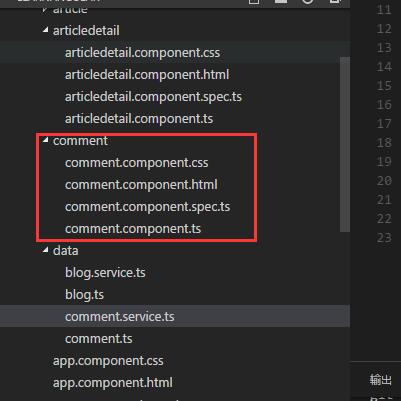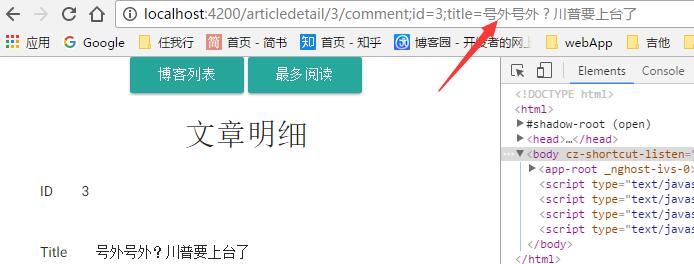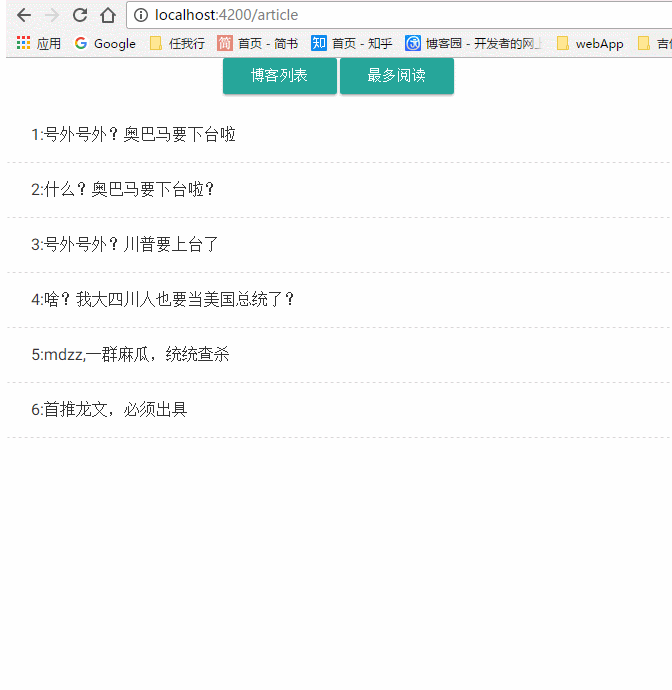Angular2入門系列教程6-路由(二)-使用多層級路由並在在路由中傳遞複雜引數
之前介紹了簡單的路由以及傳參,這篇文章我們將要學習複雜一些的路由以及傳遞其他附加引數。一個好的路由系統可以使我們的程式更好的工作。
假設你已經跟上了我們的進度。
我們來為我們的文章明細新增一個評論框;當我們在明細中點選評論的時候,在我們的明細頁面顯示評論,這裡,我們就可以完全把明細頁面看成一個獨立的路由,可以建立自己的子路由頁面,做一些評論,分享等操作。
那,首先在data目錄下建立我們的評論實體Commen和評論服務Comment.service

1 export class Comment{
2 id:number;
3 userName:string;
4 content:string;
5 blogId:number;
6 }
1 import {Comment} from './comment'
2 export let Comments:Comment[]=[];
3 export class CommentService
4 {
5 public AddComment(com:Comment)
6 {
7 com.id=this.GetMaxId();
8 Comments.push(com);
9 }
10 public GetBlogComments(blogId:number):Comment[]
11 {
12 return Comments.filter(x=>x.blogId==blogId);
13 }
14 private GetMaxId():number
15 {
16 var maxId=1;
17 Comments.forEach(x=>{
18 if(x.id>maxId)
19 maxId=x.id;
20 });
21 return maxId;
22 }
23 }作為服務,我們的commen.service提供了獲取相應部落格的評論以及新增評論的功能!然後我們在app.module.ts中的provider陣列中新增我們的CommnetService服務類
那麼,資料準備好了,現在我們來建立我們的評論頁面
在App資料夾下建立以下東西(希望你是用外掛直接生成,這樣可以節約很多時間,外掛可以幫我們直接初始化這些元件,這樣我們可以直接使用而不報錯),但是我們先去處理路由問題,讓我們可以在articleDetai中直接導航到這個元件

之前我們談到的路由是要用<router-outlet></router-outlet>去顯示元件,我們自然要在article.detail.html中新增這麼一句話
然後為了我們能找文章明細中進行,導航,我們需要配置一下路由檔案。這次,我們新建一個路由配置檔案,我推薦這樣做,因為,我們的程式始終是分模組的,不同模組用自己的路由就行了,而不是所有的路由都配置在一個檔案中
我們在根目錄(app.routing同級)下面建立articleDetail.routing.ts,鍵入一下程式碼

1 import { NgModule } from '@angular/core';
2 import { RouterModule, Routes } from '@angular/router';
3
4 import { CommentComponent } from './comment/comment.component';
5 import { ArticledetailComponent } from './articledetail/articledetail.component';
6
7 const articleDetailRoutes: Routes = [
8 {
9 path: 'articledetail/:id',
10 component: ArticledetailComponent,
11 children: [
12 {
13 path: 'comment',
14 component: CommentComponent
15 }
16 ]
17 }
18 ];
19 @NgModule({
20 imports: [
21 RouterModule.forChild(articleDetailRoutes)
22 ],
23 exports: [
24 RouterModule
25 ]
26 })
27 export class ArticleDetailRoutingModule { }
我們看到有個children的節點,這個就是我們配置路由子節點的地方
然後我們將app.routing.ts中關於articledetail的路由刪掉

1 const routes:Routes=[
2 { path: 'article',component: ArticleComponent},
3 { path: '',redirectTo:"/article",pathMatch: 'full'}
4 ];
然後,我們在app.moudule.ts中新增本次路由相關的資訊

1 import { BrowserModule } from '@angular/platform-browser';
2 import { NgModule } from '@angular/core';
3 import { FormsModule } from '@angular/forms';
4 import { HttpModule } from '@angular/http';
5 import { AppRoutingModule } from './app.routing';
6 import { ArticleDetailRoutingModule } from './articledetail.routing';
7
8 import {BlogService} from './data/blog.service';
9 import {CommentService} from './data/comment.service';
10
11 import { AppComponent } from './app.component';
12 import { ArticleComponent } from './article/article.component';
13 import { ArticledetailComponent } from './articledetail/articledetail.component';
14 import { CommentComponent } from './comment/comment.component';
15
16
17 @NgModule({
18 declarations: [
19 AppComponent,
20 ArticleComponent,
21 ArticledetailComponent,
22 CommentComponent
23
24 ],
25 imports: [
26 BrowserModule,
27 FormsModule,
28 HttpModule,
29 ArticleDetailRoutingModule,
30 AppRoutingModule
31
32 ],
33 providers: [BlogService,CommentService],
34 bootstrap: [AppComponent]
35 })
36 export class AppModule { }
路由可以用了,我們現在來到articleDetail元件,具體編寫一下怎麼路由
在html中新增程式碼
|
1 |
|
然後在ts中編寫事件
|
1 2 3 4 |
|
好了,一切準備就緒,現在,我們的子路由可以用了,如果不出意外,點選評論按鈕,你可以看到以下內容

到此,我們實現了多級路由,那麼,現在來看看傳遞複雜引數,那,我們就把我們的部落格的標題和id傳過去吧
在articleDetail元件中的doComment編寫
|
1 2 3 4 |
|
我們這裡處理了兩個引數,[]中"comment"表示要導航到的路由,{}裡面的內容是我們傳遞的引數;relativeTo表示相對與aRoute的路徑,我們先來看看這樣做的效果

我們看到,在我們的位址列,路由之外,用分號分割了我們傳遞的引數,這就是Angular2路由中傳遞引數的方式,之後我們要做的就是在我們的Comment裡面接收這些引數,這裡直接貼出我們的Comment元件的完整程式碼
comment.component.ts

1 import { Component, OnInit,Input } from '@angular/core';
2 import {ActivatedRoute,Params,Router} from '@angular/router';
3 import { Location } from '@angular/common';
4
5 import {Comment} from '../data/comment';
6 import {CommentService} from '../data/comment.service';
7
8 import 'rxjs/add/operator/switchMap';
9
10 @Component({
11 selector: 'comment',
12 templateUrl: './comment.component.html'
13 })
14
15 export class CommentComponent implements OnInit {
16 BlogTitle:string;
17 private comments:Comment[];
18 private com:Comment=new Comment();
19 private blogId:number;
20 constructor(
21 private cService: CommentService,
22 private aRoute: ActivatedRoute,
23 private router: Router,
24 private location: Location
25 ){}
26 ngOnInit() {
27 let id=this.aRoute.params
28 .subscribe(params=>{
29 this.comments=this.cService.GetBlogComments(+params["id"]);
30 this.blogId=+params["id"];
31 this.BlogTitle=params["title"];
32 })
33 }
34 sumComment()
35 {
36 if(this.com.userName&&this.com.content)
37 {
38 this.com.blogId=this.blogId;
39 this.cService.AddComment(this.com);
40 this.comments=this.cService.GetBlogComments(this.blogId);
41 console.log(this.comments);
42 this.com=new Comment();
43 }
44 }
45 }
html

1 <div class="container">
2 <h2>Blog: {{BlogTitle}}</h2>
3 <div class="comment">
4 <div class="section">
5 <div *ngFor="let com of comments">
6 <div>
7 <span>名字:</span>
8 <span>{{com.userName}}</span>
9 </div>
10 <div >
11 <span>評論內容:</span>
12 <span>{{com.content}}</span>
13 </div>
14 <div class="divider"></div>
15 </div>
16 </div>
17 </div>
18 <div class="divider red"></div>
19 <div>
20 <div class="section">
21 <div class="">
22 來,評論一下
23 </div>
24 <div>
25 <input type="text" placeholder="你的名字" [(ngModel)]="com.userName" class="">
26 <input type="text" placeholder="說點兒什麼" [(ngModel)]="com.content" class="">
27 </div>
28 <div>
29 <button class="btn" (click)="sumComment()">提交</button>
30 </div>
31 </div>
32 </div>
33 </div>
我們直接在程式碼裡面通過route的params屬性獲取了路由引數,然後處理它;這裡的params是一個Observable型別的,我們直接呼叫它的Subscribe方法(以後再介紹),獲取到params,通過一些操作,將這些資料獲取出來,顯示在頁面上,我們來看看我們做的效果

這就是我們本篇文章的內容!
也許,許多人會問了,我們可以直接在這裡傳遞一個類的資料麼,比如我們就直接傳遞blog:this.blog ,把整個Blog傳遞過去,那我只能告訴不可以,為什麼?我們來看看Angular2路由引數的定義吧

這裡的定義是key:string,也就是,我們的引數只能傳遞string型別的過去
我們並不推薦用這種方式傳遞很多引數到子元件中去,我們可以採用其他方式,比如localStorage;如果你非要這麼做,也有解決方法,用JSON.stringify將你的類變成json字串,到子元件接收之後,再用JSON.parse重新變成一個Object!(很蠢不是麼?)
關於路由暫時就介紹這麼多,Angular2有更多關於路由的知識,有興趣的同學可以直接到官網去看,或者,我把這個系列寫完了再回頭寫一個!在我看來,我們日常開發用不到那麼多東西,就不在這裡介紹了
更新ing。。。

